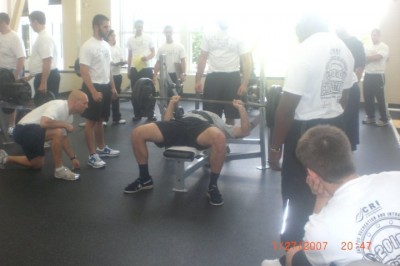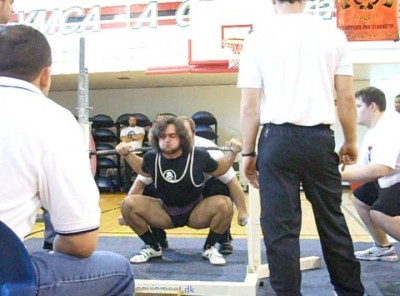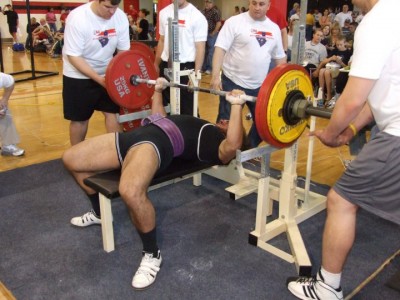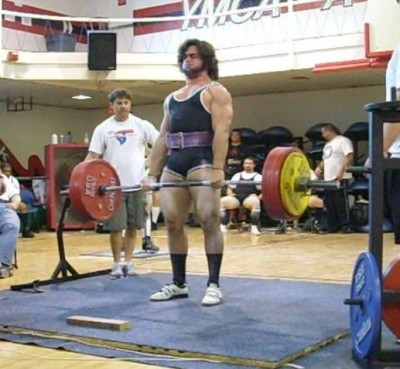The following is a post by AC. This past weekend he handles some lifters in a non-sanctioned powerlifting meet. I talked to him throughout the meet, and there were some things that occurred that ticked him off pretty well. Here goes…
———-
This past weekend, the college I currently attend held its annual “Show of Strength”. It is a school-run event directed by employees of the university’s rec center. I had a few people I coach (for free) lifting in the meet so I decided to go and help them. This was the school’s 5th annual meet and you would think they are pretty proficient at running a competition by now, right? Wrong . . . Wrong. The meet director had no prior experience in powerlifting and the head judges were incompetent as well. I’ll get to that soon. I had a bad taste in my mouth to begin with because of the people running the show, but during the rules briefing my suspicions of a poorly run meet were revealed to true.
Right off the start this 150 pound young male puts on his microphone to welcome us to the “5th annual show of strength”. He goes on about how the each lifter will have three tests to complete. Yes, tests. Not lifts. He calls each lift a test, rarely calling them the lift that they actually are. This was really annoying (Note by Justin: I’ll vouch for how annoyed AC was. I was on the phone with him during this briefing, and he was livid about the usage of goofy terminology). After that one of the head judges proceeds to call the lifters over to one side of the bleachers for the rules briefing. He goes on for a few minutes on why we should listen to him in the first place; he has experience in “strength and conditioning”, worked with some college football team, and has helped the L.A. Angels. This obviously means he knows lots about powerlifting. The briefing goes on for a few more minutes and consisted of three demos on how to do each lift and what to listen for with the commands.
Now in my experience you do not show up to a powerlifting meet not knowing how to squat, bench, and deadlift so it wouldn’t make sense that the lifts had to be described and taught to the lifters. I can understand explaining the commands, but not getting (crappy) tips on how to actually perform the lifts.
The warm-ups start and fifteen or so lifters have ten minutes to warm up. It’s ok though; there are three squat racks and a smith machine available to warm up on. Yes, they were told to use the smith machine to warm-up with. The silliness kept increasing.
The squatting started, so far so good. The bars were loaded in ascending order just like any other meet. There were few enough people to were all the weight classes went in one flight. My friend Brittney, who I coach, crushed all three of her attempts on squats, so that was pretty epic. When my other friends were lifting later in the flight I noticed some inaccurate judging. The more the “Tests” went on the more the judging degraded. Some squats were two or three inches high and they were getting the thumbs up. Just about no one, besides the people I coach, listened to all of the commands. The “Rack” command apparently became an option. Even the judge who gave the rack command was accepting attempts when lifters didn’t listen to him. The guy who gives the fucking commands! Can you believe that?
The biggest squat was 460 from a guy who I overheard weigh in at 199. His was a high bar squat that was 3 inches above parallel and he didn’t wait for the rack command, but he got two enthusiastic thumbs ups from both judges. My friend Dylan squatted just fine, but Justin S. got called for a “double-bounce” on his first attempt. I guess it was invisible to my eyes. He nailed his second and third attempt. Justin also got held at the top of the squat for about 7 seconds because the judge’s thoughts were lost (probably thinking about how good his biceps look), so I had to yell to remind this fool to give the rack command. He eventually did.
I am not going to go into too much detail on the bench press. My friend Taylor made a prediction that only the people we had coached would actually follow any of the commands. Actually, one other guy actually followed the rules, but just one. The judges gave thumbs up for people that didn’t wait and the spotters kept taking the bar before the judge gave the signal. There was a multitude of things that went wrong on bench. The silliness was accepted by the inexperienced staff.

Justin S. actually follows commands on this bench attempt
The deadlift…oh jeez. First, the judge only gave an auditory signal of down at the top of the lift (and did not give a hand signal) which is almost impossible to hear when you are actually deadlifting a max attempt. You were also allowed to drop the bar from your hands. So everyone who deadlifted “a lot of weight” got to drop the bar like a bunch of goons. Some of the ugliest lifting was occurring at this point in the meet with horribly rounded backs. Brittney, Dylan, and Justin all PR’d on their pulls which was awesome. I’m so proud of them, AND they all lowered the bar back down as well. Gustavo (who posts here) was also there and I believe he had some PR’s as well. Dylan pulled 575, and then on his second attempt they mis-loaded the bar which caused him to miss the lift. This was disappointing. There was another guy who pulled 575 at 199, and it was pretty impressive.
All in all this meet was horribly run, the judging was poor, and most of all I was really hungry (Note by Justin: This means AC was growly).
–AC
———-
Instead of looking at this as a big bashing article, look at it as a warning to any competitions you may find yourself in. If you’ve been following the site, you know that we really preach on putting yourself on the line in some form of competition. However, there are federations that have a sanctioned set of rules for a reason. As with licenses in certifications, it guarantees some baseline competence with the quality of the product. In this case, a sanctioned meet from a credible organization dictates how the lifts will be judged, and some baseline requirements for how the meet is run. Imagine if you were beaten by the lifter who was allowed to ignore the judges’ commands and squat three inches high — you’d be pretty pissed if incompetence prevented you from winning. Also, the more experienced the meet director is, the more smooth the meet will run. Be cognizant of these little details so that you can get the best out of your competitive spirit.



